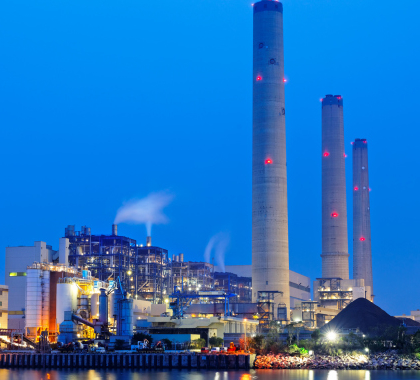Oregon lawmakers unveiled draft companion bills in the state Senate and House designed to force reductions of greenhouse gas emissions.
Senate Bill 1507 and House Bill 4001, the Clean Energy Jobs Bill (CEJB), would set strict limits on greenhouse gas emissions from three economic sectors accounting for 80 percent of carbon dioxide emissions in Oregon.
Carbon dioxide emitters in transportation, electric and gas utilities, and industry would be required to purchase allowances for their output. The amount of carbon-dioxide-equivalent greenhouse gas emissions permitted by the state, known as the carbon cap, would be reduced over time. The “cap-and-invest” bill attempts to reduce the state’s greenhouse gas emissions to 45 percent below 1990 levels by 2035 and 80 percent below 1990 levels by 2050.
News reports estimate the annual revenues generated from the allowance auctions will top $700 million annually.
High Costs, Financial Support
Economic estimates show Oregonians would pay higher prices for energy and goods and services if CEJB becomes law.
Economic analyses indicate Oregon drivers would see an immediate 0.16 cents per gallon increase in the price of fuel, adding $50 to $125 more per month to drivers’ fuel bills, depending on where in the state they live.
Portland General Electric (PGE), one of the largest utilities in Oregon, estimates CEJB would raise the price of electricity for residential ratepayers by 6.6 percent in 2021 and by as much as 27 percent by 2030, with businesses facing even steeper increases.
The proceeds of the allowance auctions would be divided among a variety of programs, with portions of the revenues directed toward homeowner energy efficiency upgrades, rate credits for lower-income households, and to provide financial support, mental health services, and job training for workers and investment in communities affected when companies close or move to other states without carbon restrictions and hence with lower energy costs.
‘No Impact on the Environment’
Oregon state Sen. Alan Olsen (R-Canby) says the bill will do nothing to fight climate change.
“If cap and invest passes in Oregon, it will have no impact on the environment at all, because in a global environment Oregon produces one-tenth of one percent of the global emissions,” Olsen said. “Reducing Oregon’s emissions by 1.4 million metric tons per year will be insignificant in the large scale of world emissions.
“Under the Paris climate agreement, China will emit 250 million metric tons of CO2 per year while we [in the United States] reduce our emissions,” said Olsen. “Even if Oregon could go to zero emissions tomorrow, it would have absolutely no impact on climate.”
Tim Benson, a policy analyst for The Heartland Institute, which publishes Environment & Climate News, says CEJB will have no effect on climate change.
“Because Oregon isn’t even responsible for 1 percent of U.S. greenhouse gas emissions, even if the state eliminated all of its greenhouse gas emissions its climate impact would be infinitesimal,” Benson said.
Forecasts High Costs
Olsen says Oregonians will pay a high price for the CEJB.
“The bill is designed to make any producer of CO2 over 25,000 metric tons pay for allowances for the privilege of emitting,” said Olsen. “Electricity prices would rise significantly due to this bill.
“At full value, Pacific Power would have to pay over $136 million for their allowances, PGE would have to pay over $103 million, while natural gas suppliers would have to pay over $195 million for their greenhouse gas output,” Olsen said.
Olsen says provisions in the bill to reduce the cost to low-income residents will push others’ energy costs even higher.
“The bill would give power companies some free allowances to sell to help mitigate the huge price rise faced by Oregonians with low or fixed incomes,” said Olsen. “If you do not fall into that category, you will face much higher electric bills.
“Because fuel prices will rise under cap-and-invest by as much as $0.19 per gallon, transportation costs will go up, which limits peoples’ free choice of mobility,” Olsen said. “Higher electricity and heating costs and other higher prices resulting from the bill will limit peoples’ ability to pursue a good life, liberty, and happiness.”
Hitting Rural Families
Benson says California’s experience shows CEJB would hit rural households especially hard.
“From what we’ve seen in California, Oregonians will likely see instantaneous gas price increases of up to 0.20 cents a gallon from CEJB,” Benson said. “This will mean immediate cost-of-living increases, especially for rural families who, naturally, use more gasoline.”
‘Do No Harm’
In written testimony submitted to the House Environment and Energy Committee and the
Senate Environment and Natural Resources Committee for hearings on Oregon’s cap-and-invest bills, John Charles, president of the Cascade Policy Institute, says even if legislators believe greenhouse gas emissions must be limited, legislation is unnecessary.
“[E]ven assuming that reducing carbon dioxide has some local benefit, the relevant trends are already moving in the right direction,” Charles stated in his testimony. “According to the most recent legislative report from the Oregon Global Warming Commission, the ‘carbon intensity’ of Oregon’s economy—that is, greenhouse gas emissions/unit of state GDP—dropped 64% from 1990 through 2015.
“This is a spectacular achievement, and it is driven almost entirely by market forces,” said Charles in his testimony. “There is no crisis in Oregon regarding carbon dioxide emissions. This is a case where you should simply ‘do no harm’ by staying out of the way.”
Kenneth Artz ([email protected]) writes from Dallas, Texas.
INTERNET INFO
John Charles, “Testimony Regarding HB 4001/SB 1507,” February 7, 2018: https://heartland.org/publications-resources/publications/testimony-regarding-hb-4001sb-1507





